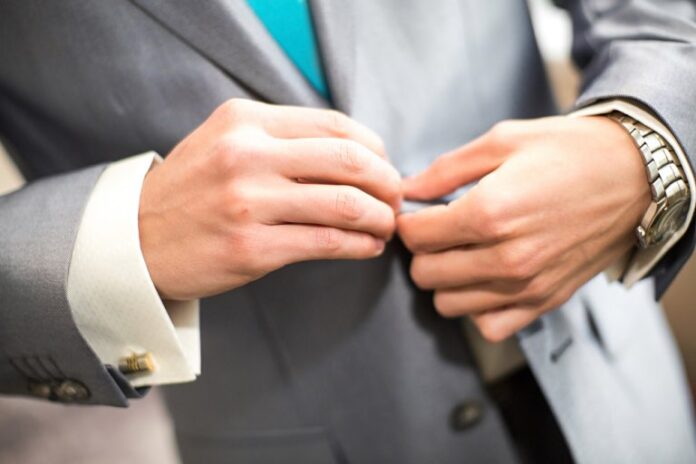As fashion evolves, men’s formal wear adapts to new trends, prioritizing comfort, versatility, and self-expression. From athleisure-inspired suits to gender-neutral silhouettes, the modern man redefines what it means to dress formally.
The tuxedo, often considered the pinnacle of men’s formal wear, surpasses a suit in formality. While a suit and a tuxedo might appear similar, they can serve different purposes. Unlike a tuxedo’s consistent theme of satin accents and a general expectation of black leather shoes, a suit allows for greater flexibility in fabric, pattern and pairing with dress shoes or even more casual footwear.
Suits are garments of versatility and can oscillate between corporate settings and semi-formal events. On the other hand, tuxedos remain the gold standard for events where “black tie” is explicitly stated or implied, such as galas, weddings, and formal dinners. The difference lies beyond the physical attributes – the message they send and the decorum they represent.
Over the centuries, formal wear has shifted, incorporating contemporary influences while maintaining its core principles. Today, we stand at a point where modern elegance is married to the classic charm of yesteryears. At this point, services like Generation Tux bridge timeless style and the efficiency of the digital age.
The Importance of Proper Fit and Tailoring
When it comes to formal wear, the fit is king. An immaculate fit ensures that the garment complements one’s physique, elevating the elegance of a royal blue suit or tuxedo. Acquiring this perfect fit often necessitates professional tailoring, an investment that pays dividends in appearance and comfort.
Subtle adjustments, like hemming trousers to the right break or tapering a jacket for a more streamlined silhouette, can distinguish between merely wearing attire and owning the room with it. While off-the-rack options have become more sophisticated, tailoring remains an indispensable aspect of men’s formal wear, allowing individuals to look like their ensemble was crafted just for them.
Accessorizing Formal Attire
Accessories serve as the exclamation points in the statement of formal attire. They are the fine details that collectively articulate sophistication. From silk pocket squares that add a flourish of color to the chest pocket to cufflinks that secure French cuffs with a shine, each accessory contributes to the overall narrative of the outfit.
When chosen correctly, timepieces blend seamlessly with the formality, and shoes – the foundation of any ensemble – must be picked with attention to the style and comfort they can offer. These small but significant choices let an individual’s personality and style preferences beam through a standardized uniform of elegance.
Color Trends and Fabric Choices
Although black remains the traditional color of choice for tuxedos, a surge of variety in hues has expanded the palette of formal wear. Deeper shades like midnight blue have emerged as sophisticated alternatives, granting a subtle departure from the norm while holding fast to the principles of formal attire.
Likewise, the fabric dynamics have changed with technological advancements and textile design. Breathable wool and sumptuous velvet offer texture and comfort, providing a sensory experience that complements visual appeal. With an array of colors and fabrics, modern men can approach formal wear with reverence for the past and an eye toward their narrative.
The Rise of Rental Services for Formal Attire
The rise of the digital era has coincided with a notable shift in formal wear acquisition. Rental services have burgeoned, offering an economically savvy option without compromising style or quality.
With these services, men can select high-end tuxedos and suits from their devices, receiving perfectly tailored outfits delivered to their doorstep. They alleviate the burden of a one-time investment for a garment that may be worn infrequently, embodying practicality and catering to the modern consumer’s desires for accessibility and efficiency.
Sustainability in Men’s Formal Wear
As the conversation around environmental stewardship takes center stage, men’s fashion has not been left behind. The industry embraces more sustainable practices, from utilizing eco-friendly materials to implementing ethical production techniques.
Renting over owning is an example of such a shift, significantly reducing waste and promoting the reuse of high-quality garments. Moreover, fashion-forward thinkers and companies now emphasize longevity over fast fashion, encouraging consumers to invest in timeless pieces that defy seasonal trends. This promotes reducing our impact through smarter fashion choices.
Preparing for a Formal Event: A Step-by-Step Guide
Proper preparation for a formal event is more than just outfit selection; it’s a ritual in poise and presentation. It starts with understanding the event’s dress code – the foundational guide to selecting appropriate attire. Ensuring every piece of the outfit, from the tie to the toe of the shoe, is in pristine condition avoids any last-minute disarray. Attention to grooming and a final look-over in the mirror are the finishing touches to a gentleman’s preparation.
By adhering to these steps, one carries not just the physical guise of formality but also the air of readiness and respect for the occasion’s significance.
